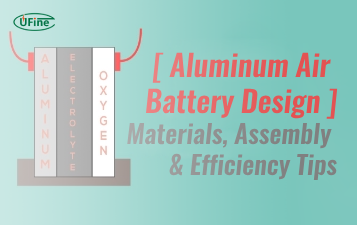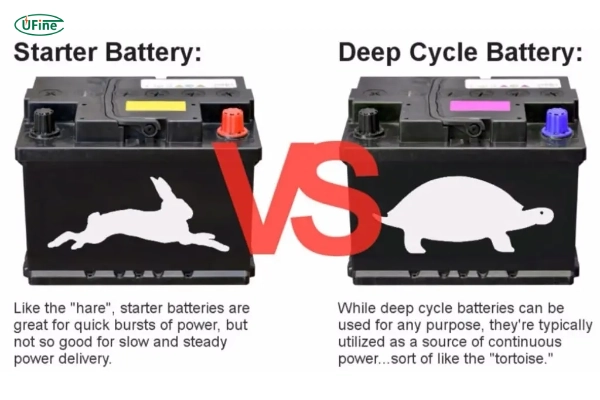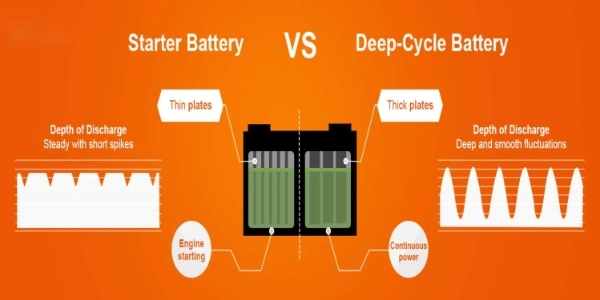What makes a deep-cycle battery different from a starting battery? Are they just two names for the same thing? Not quite! This article will explore the critical dissimilarities between deep cycle and starting batteries. Dive in to discover the distinct features and applications of each type. So, if you’ve ever wondered about the disparity between these power sources, let’s unravel the mystery together!
Part 1. What is a deep-cycle battery?
A deep cycle battery is a specialized rechargeable battery engineered to deliver consistent power output over extended periods, designed to withstand repetitive charging and discharging cycles without significant deterioration in performance. Manufacturers optimize deep cycle batteries for continuous and sustained power delivery, unlike starting batteries, which provide short bursts of high current to start engines.
Deep Cycle Battery Types:
- Flooded Lead Acid: Traditional deep cycle batteries with liquid electrolyte, typically a mixture of water and sulfuric acid. They require regular maintenance to replenish water loss due to electrolysis.
- Gel Cell: Gel deep cycle batteries feature a sealed design containing electrolytes in gel form. This construction eliminates the need for maintenance, as there is no risk of spillage or electrolyte evaporation.
- Absorbent Glass Mat (AGM): AGM deep cycle batteries utilize fiberglass mat separators to absorb and hold the electrolyte, resulting in a spill-proof and maintenance-free design. They are known for their high durability and resistance to vibration and shock.
- Lithium-ion: Lithium-ion deep-cycle batteries are gaining popularity due to their high energy density, lightweight design, and long lifespan. They offer fast charging capabilities and excellent performance in various temperatures.
- Nickel-Cadmium (NiCd): NiCd deep cycle batteries are known for their robustness and reliability, ability to withstand extreme conditions, and frequent cycling. However, they are less commonly used today due to environmental concerns associated with cadmium.
- Nickel-Metal Hydride (NiMH): NiMH deep cycle batteries offer higher energy density and improved environmental friendliness than NiCd batteries. People commonly use them in portable electronic devices and hybrid electric vehicles.
Deep Cycle Battery Characteristics:
- Deep Discharge Capability: Deep cycle batteries can be discharged to a much lower charge than starting batteries without causing damage, making them ideal for applications requiring sustained power over extended periods.
- Capacity vs. Cranking Amps: Deep cycle batteries have lower cranking amps but higher amp-hour (Ah) ratings than starting batteries, reflecting their focus on long-term energy storage rather than providing quick bursts of power.
- Thick Plate Construction: Deep cycle batteries often feature thicker lead plates than starting batteries to withstand repeated charging and discharging cycles, enhancing their durability and lifespan.
Deep Cycle Battery Advantages and Disadvantages:
Advantages:
- Long Lifespan: With proper care and maintenance, deep-cycle batteries can last for several years, making them a cost-effective investment for applications requiring reliable power over the long term.
- Versatility: Deep cycle batteries are well-suited for various applications, including renewable energy systems, electric vehicles, marine and RV use, and backup power solutions.
- Deep Discharge Tolerance: Unlike starting batteries, deep cycle batteries can tolerate deep discharges without suffering significant performance degradation, ensuring consistent power output even under heavy loads.
Disadvantages:
- Higher Initial Cost: Due to their specialized construction and materials, deep-cycle batteries typically have a higher upfront cost than starting batteries.
- Maintenance Requirements: To optimize performance and lifespan, flooded lead acid deep cycle batteries require periodic maintenance, such as adding distilled water and performing equalization charging.
- Sensitivity to Charging: Deep cycle batteries are sensitive to overcharging and undercharging, which can reduce their lifespan if not properly managed.
Deep Cycle Battery Applications:
- Off-Grid Renewable Energy Systems: People commonly use deep cycle batteries in solar, wind, and hydroelectric power systems to store energy when sunlight, wind, or water flow is unavailable.
- Electric Vehicles: Deep-cycle batteries power electric vehicles such as golf carts, forklifts, and neighborhood electric vehicles, providing reliable and efficient propulsion.
- Marine and RV Use: Deep cycle batteries serve as auxiliary power sources for boats, yachts, and recreational vehicles, supplying electricity for lighting, appliances, and navigation equipment.
- Backup Power Solutions: Deep cycle batteries provide backup power for critical infrastructure, telecommunications systems, and emergency lighting, ensuring continuity of operations during power outages.
Part 2. What is a starting battery?
A starting battery, also known as a cranking battery, is a type of lead-acid battery specifically designed to deliver a high burst of energy to start an engine. Unlike deep cycle batteries, which are optimized for sustained power output over extended periods, starting batteries prioritize a quick power surge to crank the engine and initiate ignition.
Starting Battery Types:
- Flooded Lead Acid: Automotive applications commonly use traditional starting batteries with liquid electrolytes.
- Enhanced Flooded Battery (EFB): A more robust version of flooded lead-acid batteries that withstand frequent cycling and harsh operating conditions.
- Absorbent Glass Mat (AGM): AGM starting batteries feature a sealed design with fiberglass mat separators, offering improved durability, vibration resistance, and maintenance-free operation.
Starting Battery Characteristics:
- High Cranking Amps: Starting batteries are characterized by their ability to deliver high cranking amps (CA) and cold cranking amps (CCA), providing the necessary power to start an engine quickly, especially in cold weather conditions.
- Thin Plate Design: Unlike deep cycle batteries with thicker plates for durability, starting batteries feature thinner plates to maximize surface area and facilitate rapid energy discharge during engine startup.
- Low Depth of Discharge: Starting batteries are not designed for deep discharges and may suffer damage if discharged below a certain threshold, making them unsuitable for continuous use as a primary power source.
Starting Battery Advantages and Disadvantages:
Advantages:
- High Power Output: Starting batteries excel at delivering quick bursts of energy, making them ideal for automotive applications where rapid engine startup is essential.
- Wide Availability: Starting batteries are widely available and relatively affordable, making them accessible for various vehicles and equipment.
- Quick Recharge: Starting batteries can recharge quickly after engine startup, allowing for rapid replenishment of energy reserves between starts.
Disadvantages:
- Limited Deep Cycling: Starting batteries are not designed for deep discharges and may experience reduced lifespan or damage if subjected to prolonged or repeated deep cycling.
- Lower Overall Capacity: Compared to deep cycle batteries, starting batteries typically have lower amp-hour (Ah) ratings and energy storage capacity, limiting their suitability for continuous power delivery applications.
- Maintenance Requirements: While AGM starting batteries offer maintenance-free operation, traditional flooded lead-acid starting batteries may require periodic maintenance, including checking electrolyte levels and cleaning terminals.
Starting Battery Applications:
- Automotive: Starting batteries are primarily used in automotive applications to start gasoline and diesel engines in cars, trucks, motorcycles, boats, and other vehicles.
- Power Equipment: Starting batteries also power small engines in lawnmowers, motorcycles, snowmobiles, and other power equipment requiring quick startup.
- Emergency Backup: Starting batteries may serve as backup power sources for emergency lighting systems, generators, and uninterruptible power supplies (UPS) to provide temporary power during outages.
Part 3. Differences between deep cycle vs. starting battery
Purpose:
- Manufacturers design deep-cycle batteries for sustained, long-term power delivery. They are ideal for applications requiring continuous energy output, such as renewable energy systems and electric vehicles.
- On the other hand, starting batteries prioritize providing quick bursts of energy to start engines, making them essential for automotive and power equipment applications.
Construction:
- Deep cycle batteries typically feature thicker lead plates than starting batteries, enhancing durability and enabling repeated deep discharges without damage.
- Starting batteries, with thinner plates optimized for rapid energy discharge during engine startup, facilitate high cranking amps (CCA) and cold cranking amps (CCA) performance.
Discharge Characteristics:
- Deep cycle batteries can tolerate deep discharges without significant performance degradation. In contrast, deep discharges can damage starting batteries designed for shallow cycling.
Charging Requirements:
- Deep cycle batteries may require longer charging due to their higher capacity and deeper discharge cycles. In contrast, starting batteries can recharge quickly after engine startup.
Capacity vs. Power Output:
- Deep cycle batteries have higher amp-hour (Ah) ratings and energy storage capacity but lower cranking amps than starting batteries, reflecting their focus on sustained power delivery over extended periods.
Maintenance Needs:
- Deep cycle batteries, particularly flooded lead-acid types, may require periodic maintenance, such as water replenishment and equalization charging, to optimize performance and lifespan.
- Starting batteries, especially AGM types, offer maintenance-free operation, requiring minimal upkeep beyond regular usage.
Durability and Lifespan:
- Engineers design deep-cycle batteries for prolonged use. They can typically last anywhere from 4 to 8 years, depending on usage patterns, maintenance practices, and environmental conditions.
- Due to their design optimized for quick energy delivery rather than long-term cycling, starting batteries typically have a shorter lifespan, generally lasting 2 to 5 years. However, frequent deep discharges or harsh operating conditions can significantly reduce their longevity, necessitating more frequent replacements.
Part 4. FAQs
-
Can a deep cycle battery be used to start?
Yes, you can use a deep-cycle battery to start. Still, it may not be as effective as a starting battery due to differences in design and performance characteristics. -
Is a deep-cycle battery better than a regular battery?
It depends on the application. Deep cycle batteries are better suited for sustained, long-term power delivery. In contrast, regular batteries, such as starting batteries, provide quick bursts of energy for starting engines. -
What happens if I use a deep-cycle battery in my car?
A deep-cycle battery in a car may work when starting the engine. Still, it may not provide optimal performance or lifespan compared to a dedicated starting battery. Additionally, deep-cycle batteries are not designed for the high current demands of engine starting and may suffer damage over time. -
What is the lifespan of a deep-cycle battery?
The lifespan of a deep-cycle battery can vary depending on factors such as usage patterns, maintenance practices, and environmental conditions. Generally, deep-cycle batteries can last 4 to 8 years with proper care. -
Can a completely dead deep-cycle battery be recharged?
Sometimes, you can recharge a completely dead deep-cycle battery using a specialized charger for deep discharge recovery. However, the success of recharging depends on the extent of the battery’s damage and its overall condition.
Related Tags:
More Articles

Aluminum Air Battery Design: Materials, Assembly & Efficiency Tips
An aluminum air battery uses aluminum and air to generate power. Learn its materials, assembly steps, and tips to boost energy output and efficiency.
7 Advantages of a Heated Lithium Battery in Cold Climates
Looking to power batteries in freezing temps? Heated lithium batteries excel in cold climates. Here are 7 key benefits and how they work.
How to Choose the Best Floor Scrubber Battery for Commercial Cleaning?
Selecting the ideal floor scrubber battery ensures a long runtime, rapid charging, and minimal maintenance for efficient commercial cleaning operations.
Battery for Blower vs Battery for Leaf Vacuum: Which One Should You Choose?
Battery for blower vs leaf vacuum—learn the key differences in power, fit, and runtime to choose the right battery for your outdoor tool needs.
How to Choose the Right Battery for Blower?
Choosing the right blower battery? Consider voltage, capacity, chemistry & usage. This guide helps match the best battery for peak performance.





